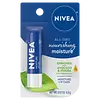What's inside
What's inside
 Key Ingredients
Key Ingredients

 Benefits
Benefits

 Concerns
Concerns

 Ingredients Side-by-side
Ingredients Side-by-side

Octyldodecanol
EmollientRicinus Communis Seed Oil
MaskingHydrogenated Rapeseed Oil
EmollientBeeswax
Emulsion StabilisingEthylhexyl Stearate
EmollientCetyl Palmitate
EmollientCetearyl Alcohol
EmollientPolyglyceryl-3 Diisostearate
EmulsifyingCopernicia Cerifera Wax
Butyrospermum Parkii Butter
Skin ConditioningSimmondsia Chinensis Seed Oil
EmollientPersea Gratissima Oil
Skin ConditioningAroma
BHT
AntioxidantLanolin
EmollientHydrogenated Coconut Oil
EmollientCera Alba
EmollientRicinus Communis Seed Oil
MaskingHomosalate
Skin ConditioningOlea Europaea Fruit Oil
MaskingTheobroma Cacao Seed Butter
EmollientEthylhexyl Salicylate
UV AbsorberStearyl Alcohol
EmollientHydrogenated Castor Oil
EmollientCamphor
MaskingEuphorbia Cerifera Cera
AstringentMenthol
MaskingVitis Vinifera Seed Oil
EmollientArachidyl Alcohol
EmollientArachidyl Glucoside
EmulsifyingBehenyl Alcohol
EmollientButyrospermum Parkii Butter
Skin ConditioningBenzyl Alcohol
PerfumingBeta-Carotene
Skin ConditioningDaucus Carota Sativa Root Extract
Skin ConditioningEucalyptus Globulus Leaf Oil
PerfumingEugenia Caryophyllus Flower Oil
MaskingEugenol
PerfumingGlycine Soja Oil
EmollientLimonene
PerfumingMenthoxypropanediol
MaskingMenthyl Lactate
MaskingMethyl Salicylate
PerfumingParfum
MaskingSaccharin
MaskingTocopherol
AntioxidantZea Mays Oil
EmulsifyingLanolin, Hydrogenated Coconut Oil, Cera Alba, Ricinus Communis Seed Oil, Homosalate, Olea Europaea Fruit Oil, Theobroma Cacao Seed Butter, Ethylhexyl Salicylate, Stearyl Alcohol, Hydrogenated Castor Oil, Camphor, Euphorbia Cerifera Cera, Menthol, Vitis Vinifera Seed Oil, Arachidyl Alcohol, Arachidyl Glucoside, Behenyl Alcohol, Butyrospermum Parkii Butter, Benzyl Alcohol, Beta-Carotene, Daucus Carota Sativa Root Extract, Eucalyptus Globulus Leaf Oil, Eugenia Caryophyllus Flower Oil, Eugenol, Glycine Soja Oil, Limonene, Menthoxypropanediol, Menthyl Lactate, Methyl Salicylate, Parfum, Saccharin, Tocopherol, Zea Mays Oil
 Reviews
Reviews

Ingredients Explained
These ingredients are found in both products.
Ingredients higher up in an ingredient list are typically present in a larger amount.
This ingredient is also known as shea butter. It is an effective skin hydrator and emollient.
Emollients help soothe and soften your skin. It does this by creating a protective film on your skin. This barrier helps trap moisture and keeps your skin hydrated. Emollients may be effective at treating dry or itchy skin.
Shea butter is rich in antioxidants. Antioxidants help fight free-radicals, or molecules that may harm the body. It is also full of fatty acids including stearic acid and linoleic acid. These acids help replenish the skin and keep skin moisturized.
While Shea Butter has an SPF rating of about 3-4, it is not a sunscreen replacement.
Shea butter may not be fungal acne safe. We recommend speaking with a professional if you have any concerns.
Learn more about Butyrospermum Parkii ButterRicinus Communis Seed Oil is the INCI name for castor oil.
Castor Oil helps moisturize the skin. It is rich in a fatty acid called ricinoleic acid. This fatty acid helps prevent moisture loss on the skin. This helps keep your skin soft and hydrated. Ricinoleic acid also has anti-inflammatory and pain reducing properties.
Besides hydrating the skin, castor oil is also used to hydrate hair. By keeping the hair shaft moisturized, breakage is decreased. More studies are needed to show castor oil's effective on stimulating hair growth.
Castor oil is created by cold-pressing castor seeds and then purifying the oil with heat. It was used in Ancient Egypt as fuel in lamps and to help treat eye irritation.
The term 'fragrance' is not regulated in many countries. In many cases, it is up to the brand to define this term. For instance, many brands choose to label themselves as "fragrance-free" because they are not using synthetic fragrances. However, their products may still contain ingredients such as essential oils that are considered a fragrance.
Learn more about Ricinus Communis Seed Oil